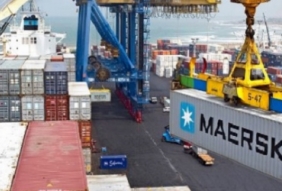
Posted on May 10, 2016
By Greg Knowler, JOC.com
Collapsing freight rates dragged Maersk Line’s first quarter net profit down 95%, with the world’s largest container carrier barely managing to remain in the black for the first three months of the year.
Maersk Group chief executive officer (CEO) Nils Andersen described it as a “break-even result” for the container transport unit in a tough market that saw Maersk Line ending the first three months of the year with a net profit of just USD37 million, a long way off its USD714 million profit registered in the first quarter of 2015 (1Q15). This result helped pull the first quarter underlying profit of the Maersk Group down by 86% from USD1.3 billion to USD214 million.
“Rates have been down to record low levels in the first quarter on the back of weak trade development in many countries. The Maersk Line’s profit of USD37 million is basically break even,” Andersen said in a conference call to reporters.
Maersk Line’s performance is regarded as an indicator of the state of the container shipping industry, and while its first quarter figures were an improvement on those of the last quarter of 2015, they show an industry struggling to improve profitability despite higher volume, lower bunker fuel prices and lower unit costs per feu carried compared to the first three months of last year.
Deteriorating market conditions in the container trades late last year continued into the first quarter with revenue at the carrier tumbling from USD6.2 billion to USD4.97 billion, a drop of 20% that was driven by average freight rates declining 26% to record low levels in the reporting period. Maersk said these weak rates were experienced across all trades, but especially in the carrier’s key European routes that it is heavily exposed to, as well as Latin American and North American trades.
The falling revenue was only partially offset by increasing volume that grew 7% year-on-year to 2.36 million feu and a 10% decrease in total costs, led by a 48% decrease in the price of fuel that pulled down the average unit cost of transporting a container by almost 5% to USD2,060.
Maersk said global container demand grew about 1% in the first quarter compared to the same period last year. The low demand growth was primarily related to a slowdown in emerging economies because of low commodity prices and structural economic challenges. Europe also remained subdued during the quarter and weaker Chinese imports further affected global trade.
Maersk noted that the industry had recently seen steps towards consolidation from both mergers and acquisitions, referring to CMA CGM acquiring NOL and Hapag-Lloyd and UASC in merger talks. It said over time this would represent a potential easing of the supply situation through more disciplined capacity management.
“We feel consolidation is good and we feel it is positive when viable and stable alliances are formed,” Andersen said. “That enables everyone to concentrate on the offering to the customer and not fight exclusively on rates.”
Andersen also covered the changing alliance structure, and said the uncertainty was adding to market volatility. “There is only one seemingly important alliance being formed now, the Ocean Alliance, and then the rest of the market that is being led out of the two leading alliances that will have to find out for themselves what to do. Either they will have to consolidate in an alliance or they will have to concentrate on very few long-haul routes or on regional activity.”
Global supply grew more than 7% compared with the same period last year. By the end of March, the Maersk Line fleet consisted of 287 owned vessels (1.8 million teu) and 318 chartered vessels (1.1 million teu) with a total capacity of almost 3 million teu, an increase of 2.2% compared to the first quarter of 2015 and an increase of 1% compared to the same period in 2015.
Idle capacity at the end of the first quarter was 34,000 teu (four vessels), and the idle capacity was about 2% of the total idle capacity in the market.
The carrier said managing capacity in line with the low container demand growth in the industry remained a focus area, and the closure of four services in 2015 resulted in an improved fleet utilisation compared to both the 1Q15 and the 4Q15.
Michel Looten, director maritime at Seabury Group, said, “Maersk is generally regarded as one of the best run lines, so if they are in trouble, generally people assume other global lines are doing worse,” he said.
“Some lines focusing on non-global trades, such as the Wan Hai’s of this world, might perform well, but as a bellwether for the global liner industry, Maersk’s results will be seen a hugely important regarding the state of the industry.”
The industry is not in a good state at all with several shipping lines facing daunting financial hurdles. South Korean carriers Hanjin Shipping and Hyundai Merchant Marine are heading for state control with the Korea Development Bank stepping in with debt restructuring measures aimed at saving off bankruptcy.
Source: IHS





